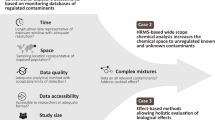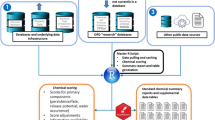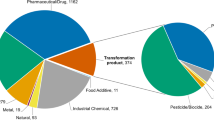Abstract
Hydraulic-fracturing fluids and wastewater from unconventional oil and natural gas development contain hundreds of substances with the potential to contaminate drinking water. Challenges to conducting well-designed human exposure and health studies include limited information about likely etiologic agents. We systematically evaluated 1021 chemicals identified in hydraulic-fracturing fluids (n=925), wastewater (n=132), or both (n=36) for potential reproductive and developmental toxicity to triage those with potential for human health impact. We searched the REPROTOX database using Chemical Abstract Service registry numbers for chemicals with available data and evaluated the evidence for adverse reproductive and developmental effects. Next, we determined which chemicals linked to reproductive or developmental toxicity had water quality standards or guidelines. Toxicity information was lacking for 781 (76%) chemicals. Of the remaining 240 substances, evidence suggested reproductive toxicity for 103 (43%), developmental toxicity for 95 (40%), and both for 41 (17%). Of these 157 chemicals, 67 had or were proposed for a federal water quality standard or guideline. Our systematic screening approach identified a list of 67 hydraulic fracturing-related candidate analytes based on known or suspected toxicity. Incorporation of data on potency, physicochemical properties, and environmental concentrations could further prioritize these substances for future drinking water exposure assessments or reproductive and developmental health studies.
This is a preview of subscription content, access via your institution
Access options
Subscribe to this journal
Receive 6 print issues and online access
$259.00 per year
only $43.17 per issue
Buy this article
- Purchase on Springer Link
- Instant access to full article PDF
Prices may be subject to local taxes which are calculated during checkout

Similar content being viewed by others
References
Adgate JL, Goldstein BD, McKenzie LM . Potential public health hazards, exposures and health effects from unconventional natural gas development. Environ Sci Technol 2014; 48: 8307–8320.
United States Department of Energy & National Energy Technology Laboratory. Modern Shale Gas Development in the United States: An Update, 2013. Available from https://www.netl.doe.gov/File%20Library/Research/Oil-Gas/shale-gas-primer-update-2013.pdf.
United States Environmental Protection Agency. Assessment of the Potential Impacts of Hydraulic Fracturing for Oil and Gas on Drinking Water Resources. EPA/600/R-15/047a, 2015. Available from http://cfpub.epa.gov/ncea/hfstudy/recordisplay.cfm?deid=244651.
United States Environmental Protection Agency. Study of the Potential Impacts of Hydraulic Fracturing on Drinking Water Resources: Progress Report. EPA/601/R-12/011, 2012. Available from http://www2.epa.gov/hfstudy/study-potential-impacts-hydraulic-fracturing-drinking-water-resources-progress-report-0.
Maule AL, Makey CM, Benson EB, Burrows IJ, Scammell MK . Disclosure of hydraulic fracturing fluid chemical additives: analysis of regulations. New Solut 2013; 23: 167–187.
Getzinger GJ, O'Connor MP, Hoelzer K, Drollette BD, Karatum O, Deshusses MA et al. Natural gas residual fluids: sources, endpoints, and organic chemical composition after centralized waste treatment in Pennsylvania. Environ Sci Technol 2015; 49: 8347–8355.
Shih JS, Saiers JE, Anisfeld SC, Chu Z, Muehlenbachs LA, Olmstead SM . Characterization and analysis of liquid waste from marcellus shale gas development. Environ Sci Technol 2015; 49: 9557–9565.
Stringfellow WT, Domen JK, Camarillo MK, Sandelin WL, Borglin S . Physical, chemical, and biological characteristics of compounds used in hydraulic fracturing. J Hazard Mater 2014; 275: 37–54.
Penning TM, Breysse PN, Gray K, Howarth M, Yan B . Environmental health research recommendations from the Inter-Environmental Health Sciences Core Center Working Group on unconventional natural gas drilling operations. Environ Health Perspect 2014; 122: 1155–1159.
Institute of Medicine. Health Impact Assessment of Shale Gas Extraction: Workshop Summary. The National Academies Press: Washington, DC, 2014. Available from http://www.nap.edu/openbook.php?record_id=18376.
Vengosh A, Jackson RB, Warner N, Darrah TH, Kondash A . A critical review of the risks to water resources from unconventional shale gas development and hydraulic fracturing in the United States. Environ Sci Technol 2014; 48: 8334–8348.
Ferrar KJ, Kriesky J, Christen CL, Marshall LP, Malone SL, Sharma RK et al. Assessment and longitudinal analysis of health impacts and stressors perceived to result from unconventional shale gas development in the Marcellus Shale region. Int J Occup Environ Health 2013; 19: 104–112.
Brantley SL, Yoxtheimer D, Arjmand S, Grieve P, Vidic R, Pollak J et al. Water resource impacts during unconventional shale gas development: the Pennsylvania experience. Int J Coal Geol 2014; 126: 140–156.
Jackson RE, Gorody AW, Mayer B, Roy JW, Ryan MC, Van Stempvoort DR . Groundwater protection and unconventional gas extraction: the critical need for field-based hydrogeological research. Groundwater 2013; 51: 488–510.
Osborn SG, Vengosh A, Warner NR, Jackson RB . Methane contamination of drinking water accompanying gas-well drilling and hydraulic fracturing. Proc Natl Acad Sci USA 2011; 108: 8172–8176.
Rozell DJ, Reaven SJ . Water pollution risk associated with natural gas extraction from the Marcellus Shale. Risk Anal 2012; 32: 1382–1393.
Shonkoff SB, Hays J, Finkel ML . Environmental public health dimensions of shale and tight gas development. Environ Health Perspect 2014; 122: 787–795.
Vengosh A, Warner N, Jackson R, Darrah T . The effects of shale gas exploration and hydraulic fracturing on the quality of water resources in the United States. Procedia Earth Planet Sci 2013; 7: 863–866.
Warner NR, Jackson RB, Darrah TH, Osborn SG, Down A, Zhao K et al. Geochemical evidence for possible natural migration of Marcellus Formation brine to shallow aquifers in Pennsylvania. Proc Natl Acad Sci USA 2012; 109: 11961–11966.
Gross SA, Avens HJ, Banducci AM, Sahmel J, Panko JM, Tvermoes BE . Analysis of BTEX groundwater concentrations from surface spills associated with hydraulic fracturing operations. J Air Waste Manage Assoc (1995) 2013; 63: 424–432.
Llewellyn GT, Dorman F, Westland JL, Yoxtheimer D, Grieve P, Sowers T et al. Evaluating a groundwater supply contamination incident attributed to Marcellus Shale gas development. Proc Natl Acad Sci USA 2015; 112: 6325–6330.
Jackson RB, Vengosh A, Darrah TH, Warner NR, Down A, Poreda RJ et al. Increased stray gas abundance in a subset of drinking water wells near Marcellus shale gas extraction. Proc Natl Acad Sci USA 2013; 110: 11250–11255.
Vidic RD, Brantley SL, Vandenbossche JM, Yoxtheimer D, Abad JD . Impact of shale gas development on regional water quality. Science (New York, NY) 2013; 340: 1235009.
Burton GA, Jr, Basu N, Ellis BR, Kapo KE, Entrekin S, Nadelhoffer K . Hydraulic "fracking": are surface water impacts an ecological concern? Environ Toxicol Chem 2014; 33: 1679–1689.
Pennsylvania Land Trust Association. Marcellus Shale Drillers in Pennsylvania Amass 1614 Violations Since 2008. 2010. Available from http://conserveland.org/violationsrpt.
Hildenbrand ZL, Carlton DD, Jr, Fontenot BE, Meik JM, Walton JL, Taylor JT et al. A comprehensive analysis of groundwater quality in the Barnett Shale Region. Environ Sci Technol 2015; 49: 8254–8262.
Harkness JS, Dwyer GS, Warner NR, Parker KM, Mitch WA, Vengosh A . Iodide, bromide, and ammonium in hydraulic fracturing and oil and gas wastewaters: environmental implications. Environ Sci Technol 2015; 49: 1955–1963.
Ziemkiewicz P, Quaranta JD, McCawley M . Practical measures for reducing the risk of environmental contamination in shale energy production. Environ Sci Process Impacts 2014; 16: 1692–1699.
Kassotis CD, Tillitt DE, Davis JW, Hormann AM, Nagel SC . Estrogen and androgen receptor activities of hydraulic fracturing chemicals and surface and ground water in a drilling-dense region. Endocrinology 2014; 155: 897–907.
Colborn T, Kwiatkowski C, Schultz K, Bachran M . Natural gas operations from a public health perspective. Hum Ecol Risk Assess 2011; 17: 1039–1056.
Webb E, Bushkin-Bedient S, Cheng A, Kassotis CD, Balise V, Nagel SC . Developmental and reproductive effects of chemicals associated with unconventional oil and natural gas operations. Rev Environ Health 2014; 29: 307–318.
McKenzie LM, Guo R, Witter RZ, Savitz DA, Newman LS, Adgate JL . Birth outcomes and maternal residential proximity to natural gas development in rural colorado. Environ Health Perspect 2014; 122: 412–417.
Stacy SL, Brink LL, Larkin JC, Sadovsky Y, Goldstein BD, Pitt BR et al. Perinatal outcomes and unconventional natural gas operations in Southwest Pennsylvania. PLoS One 2015; 10: e0126425.
Rothwell CJ, Hamilton CB, Leaverton PE . Identification of sentinel health events as indicators of environmental contamination. Environ Health Perspect 1991; 94: 261–263.
Shy C, Greenberg R, Winn D . Sentinel health events of environmental contamination: a consensus statement. Environ Health Perspect 1994; 102: 316–317.
FracFocus Alliance. Available from http://fracfocus.org/ (accessed 11 August 2015).
Scialli AR . Data availability in reproductive and developmental toxicology. Obstet Gynecol 1994; 83: 652–656.
Roberson JA . What's next after 40 years of drinking water regulations? Environ Sci Technol 2011; 45: 154–160.
United States Environmental Protection Agency. Integrated Risk Information System. Available from http://www.epa.gov/iris/ (accessed 7 August 2015).
United States Environmental Protection Agency. National Primary Drinking Water Regulations, 2009. Available from http://water.epa.gov/drink/contaminants/ (accessed 11 August 2015).
United States Environmental Protection Agency. Drinking Water Contaminant Candidate List (CCL) and Regulatory Determination. Available from http://www2.epa.gov/ccl (accessed 11 August 2015).
United States Environmental Protection Agency. Estimation Programs Interface Suite for Microsoft Windows (EPI Suite), 2012. Available from http://www.epa.gov/opptintr/exposure/pubs/episuite.htm (accessed 31 July 2015).
United States Environmental Protection Agency. Sustainable Futures and P2 Framework Manual. 2012. Available from http://www.epa.gov/opptintr/sf/pubs/sf-p2-manual.html.
Wattenberg EV, Bielicki JM, Suchomel AE, Sweet JT, Vold EM, Ramachandran G . Assessment of the acute and chronic health hazards of hydraulic fracturing fluids. J Occup Environ Hyg 2015; 12: 611–624.
Kahrilas GA, Blotevogel J, Stewart PS, Borch T . Biocides in hydraulic fracturing fluids: a critical review of their usage, mobility, degradation, and toxicity. Environ Sci Technol 2015; 49: 16–32.
United States House of Representatives Committee on Energy and Commerce, Minority Staff. Chemicals Used in Hydraulic Fracturing, 2011. Available from http://democrats.energycommerce.house.gov/sites/default/files/documents/Hydraulic-Fracturing-Chemicals-2011-4-18.pdf.
Rogers JD, Burke TL, Osborn SG, Ryan JN . A framework for identifying organic compounds of concern in hydraulic fracturing fluids based on their mobility and persistence in groundwater. [letter]. Environ Sci Technol 2015; 2: 158–164.
Matthews EJ, Kruhlak NL, Daniel Benz R, Ivanov J, Klopman G, Contrera JF . A comprehensive model for reproductive and developmental toxicity hazard identification: II. Construction of QSAR models to predict activities of untested chemicals. Regul Toxicol Pharmacol 2007; 47: 136–155.
United States Environmental Protection Agency. Regulation of Hydraulic Fracturing Under the Safe Drinking Water Act, 2014. Available from http://water.epa.gov/type/groundwater/uic/class2/hydraulicfracturing/wells_hydroreg.cfm (accessed 10 July 2015).
Jacquet JB . Review of risks to communities from shale energy development. Environ Sci Technol 2014; 48: 8321–8333.
Author information
Authors and Affiliations
Corresponding author
Ethics declarations
Competing interests
The authors declare no conflict of interest.
Rights and permissions
About this article
Cite this article
Elliott, E., Ettinger, A., Leaderer, B. et al. A systematic evaluation of chemicals in hydraulic-fracturing fluids and wastewater for reproductive and developmental toxicity. J Expo Sci Environ Epidemiol 27, 90–99 (2017). https://doi.org/10.1038/jes.2015.81
Received:
Revised:
Accepted:
Published:
Issue Date:
DOI: https://doi.org/10.1038/jes.2015.81
Keywords
This article is cited by
-
US drinking water quality: exposure risk profiles for seven legacy and emerging contaminants
Journal of Exposure Science & Environmental Epidemiology (2024)
-
Congenital anomalies associated with oil and gas development and resource extraction: a population-based retrospective cohort study in Texas
Journal of Exposure Science & Environmental Epidemiology (2023)
-
Assessing Exposure to Unconventional Oil and Gas Development: Strengths, Challenges, and Implications for Epidemiologic Research
Current Environmental Health Reports (2022)
-
Critical evaluation of human health risks due to hydraulic fracturing in natural gas and petroleum production
Archives of Toxicology (2020)
-
Biological Effects of Elevated Major Ions in Surface Water Contaminated by a Produced Water from Oil Production
Archives of Environmental Contamination and Toxicology (2019)



